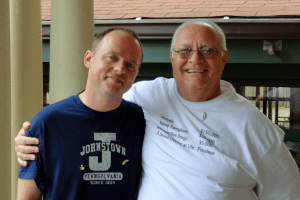The Challenge: Polycystic Kidney Disease
Gerald “Jerry” Ivory is one of more than 600,000 Americans diagnosed with a genetic disease called polycystic kidney disease (PKD).
“I knew that I had [PKD] decades before I had to quit working. Eventually it had affected my whole stomach cavity and I couldn’t breathe, let alone urinate,” says Jerry. “[PKD] took me down so low so slow. You don’t even realize it’s happening to you. I couldn’t walk to the end of the driveway to get my mail. It even affected my thought process.”
Eventually Jerry’s disease took its toll, and he needed to undergo kidney removal surgery, leading to a dependence on dialysis to compensate for his kidney.He explained, “When they removed my kidneys, they weighed over 40 pounds and were larger than footballs.”
The Path to Living-Donor Kidney Transplant at UPMC
Realizing that dialysis was only a short-term solution, Jerry was placed on the transplant waitlist at UPMC. Though he knew living donation was an option, no one in his immediate family qualified to be his donor.
“I have two daughters and PKD is hereditary. I passed it on to one daughter, and her daughter, at four years old, already has cysts on her kidneys,” said Jerry. “My other daughter offered to donate her kidney, but I refused. I told her that her sister might need one and she needed to save hers.”
After more than three years on the waitlist, Jerry’s niece from Ohio came forward. Unfortunately, during the evaluation process, the transplant team discovered that her medical history prevented her from being a donor.
It was then that Steve Fields came into the picture.
The Solution: A Football Advertisement
Steve, a postal worker from Oklahoma, was introduced to Jerry through a mutual friend. Though they occasionally would speak on the phone, the two spent very little time together.
In February 2012, Steve was watching football and saw a commercial in which quarterback Tom Brady was endorsing organ donation. After hearing about Jerry’s niece and her inability to donate, Steve called Jerry the next day.
“Steve always envied women because they could give birth and life and men couldn’t do that. He thought of this as his chance to give life,” Jerry says.
Though eager and willing, Steve spent significant time discussing the decision to donate with his family.
“My wife and I talked about it and there was no doubt in my mind that this is what I wanted to do. She backed me 100 percent. Although family members were concerned, they were all supportive.”
Jerry had to undergo dialysis one last time prior to the transplant surgery. Steve and his wife flew in a day before the transplant to spend that time with him. They wanted to see what exactly Jerry had been going through over the years.
“When I opened my eyes in recovery after the transplant, I knew I was better. It was like I had a new pair of glasses,” says Jerry. “To [donate your organ] to a relative or close friend is one thing, but Steve wasn’t even a very close friend. It was a true blessing.”
The Results: Spending Time with Family
Since the transplant, Jerry has been able to spend more time with his wife and family, without having to worry about extreme fatigue or dialysis.
“I’m doing way above average, I’m exceptional. There was not one hiccup throughout the transplant process, and it couldn’t have gone any smoother.”
His donor Steve can walk his normal eight to 12 miles a day carrying mail without a problem.
“After about six weeks I went back to work. The only way I can tell this happened at all is if I look at the scars, other than that it’s been a full recovery,” Steve explains.
Jerry feels extremely grateful and blessed that there are still good people like Steve who truly care about helping others.
“Of course now, Steve and I are closer than ever. We’re planning on driving to visit each other as soon as we can.”
Jerry's treatment and results may not be representative of all similar cases.
Learn More about Living-Donor Kidney Transplant
UPMC Transplant Services:
UPMC HealthBeat Blog:



















